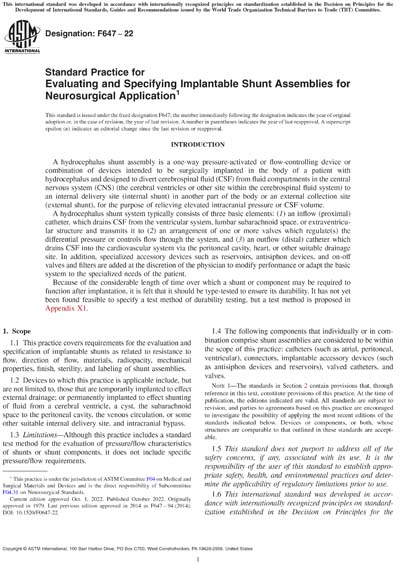Most recent
ASTM F647-22
Standard Practice for Evaluating and Specifying Implantable Shunt Assemblies for Neurosurgical Application
1.1This practice covers requirements for the evaluation and specification of implantable shunts as related to resistance to flow, direction of flow, materials, radiopacity, mechanical properties, finish, sterility, and labeling of shunt assemblies.
1.2Devices to which this practice is applicable include, but are not limited to, those that are temporarily implanted to effect external drainage; or permanently implanted to effect shunting of fluid from a cerebral ventricle, a cyst, the subarachnoid space to the peritoneal cavity, the venous circulation, or some other suitable internal delivery site, and intracranial bypass.
1.3Limitations - Although this practice includes a standard test method for the evaluation of pressure/flow characteristics of shunts or shunt components, it does not include specific pressure/flow requirements.
1.4The following components that individually or in combination comprise shunt assemblies are considered to be within the scope of this practice: catheters (such as atrial, peritoneal, ventricular), connectors, implantable accessory devices (such as antisiphon devices and reservoirs), valved catheters, and valves.
Note 1:The standards in Section 2 contain provisions that, through reference in this text, constitute provisions of this practice. At the time of publication, the editions indicated are valid. All standards are subject to revision, and parties to agreements based on this practice are encouraged to investigate the possibility of applying the most recent editions of the standards indicated below. Devices or components, or both, whose structures are comparable to that outlined in these standards are acceptable.
1.5This standard does not purport to address all of the safety concerns, if any, associated with its use. It is the responsibility of the user of this standard to establish appropriate safety, health, and environmental practices and determine the applicability of regulatory limitations prior to use.
1.6This international standard was developed in accordance with internationally recognized principles on standardization established in the Decision on Principles for the Development of International Standards, Guides and Recommendations issued by the World Trade Organization Technical Barriers to Trade (TBT) Committee.
ASTM International [astm]

